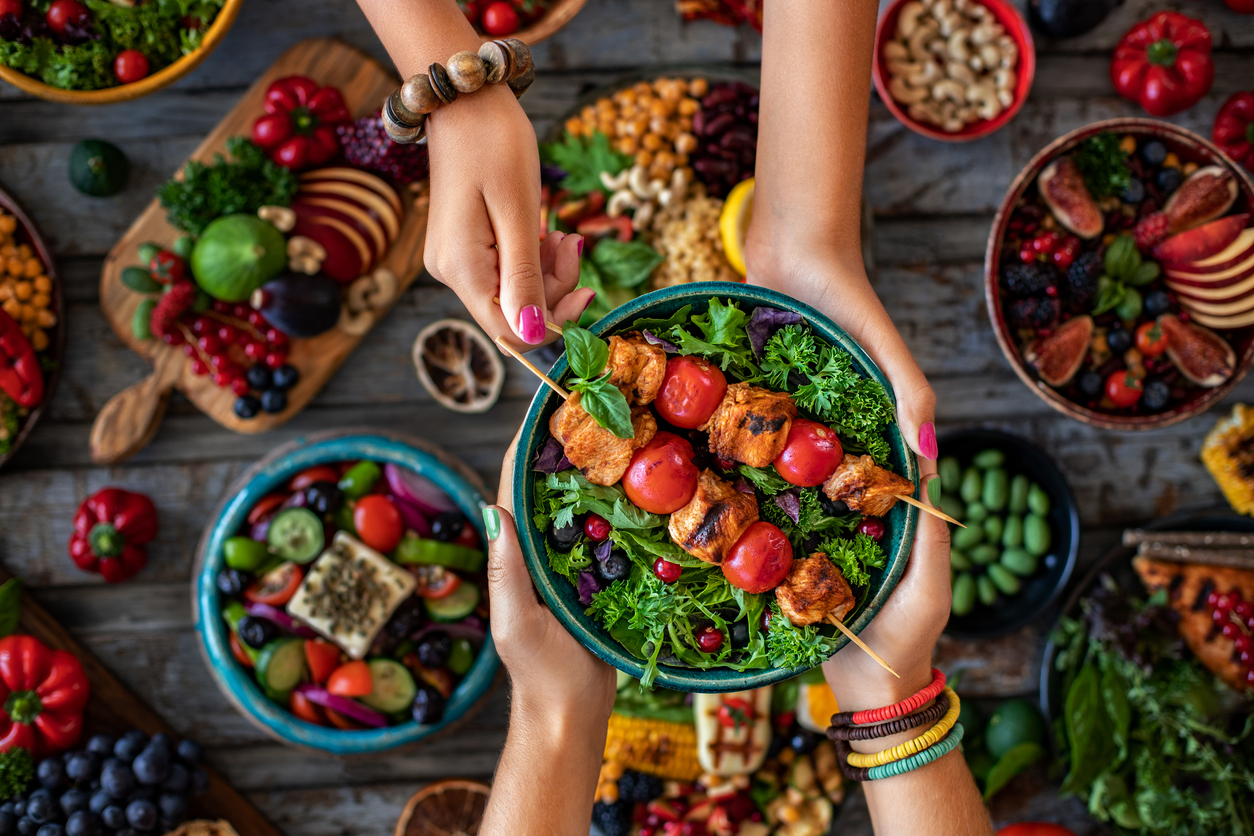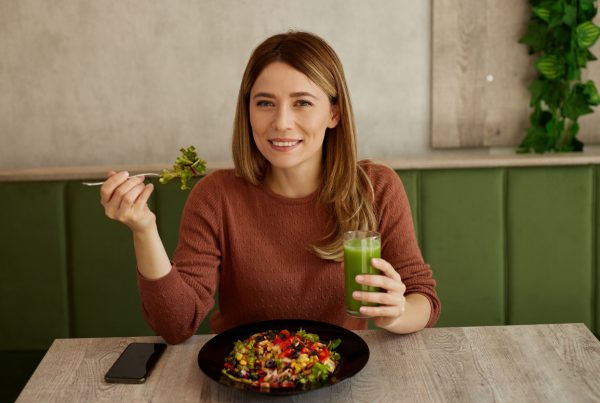Dr Linia Patel (PhD), RD explains why she doesn’t meticulously count her calories and, instead, looks beyond the numbers, as she explores understanding calories and portions for optimal health.
During my recent book tour, a recurring question was why I chose not to include calorie, carbohydrate, and protein breakdowns for each recipe. My response? Of course, calories matter—but I’m not an advocate of meticulously counting them. The reality is far more complex than simple numbers, and sometimes, stepping back and focusing on foundational nutritional principles naturally leads to a balanced intake.
Understanding Your Daily Caloric Needs 1,2
Government guidelines suggest that the average man requires 2,500 kcal per day, while the average woman needs around 2,000 kcal. However, these figures are merely broad recommendations, not precise prescriptions. Individual caloric needs vary widely based on factors such as sex, age, height, activity level, and, in some cases, even body composition. Personalized calculations offer a more tailored estimate, underscoring the fact that nutrition is not a one-size-fits-all science but rather a nuanced interplay of biology, lifestyle, and metabolism.
The Problems with Calorie Counting 3,4
You may have relied on a website or app to calculate your calorie needs, assuming the estimates are precise. You’re not alone in this belief—but unfortunately, these calculations are often inaccurate. Research suggests they can be off by as much as 25%, due to factors like, laboratory measurement errors as well as individual variations.
At the core of any so-called “personalized calorie prescription” lie assumptions based on research cohorts, meaning these estimates are only as accurate as the populations they were derived from. Various formulas are widely used to estimate energy requirements, each with its own strengths and limitations depending on age, body composition, ethnicity, and activity level. For example:
- Harris-Benedict Equation (1919): One of the earliest methods, developed from studies on healthy white men and women. However, it tends to overestimate basal metabolic rate (BMR) in modern populations.
- Mifflin-St Jeor Equation (1990): Designed for a sample of healthy white American adults, offering more accuracy for today’s population compared to Harris-Benedict.
- Cunningham Equation (1980): Particularly useful for athletes, as it accounts for lean body mass, making it more precise for highly active individuals.
- Henry Equation (2005): Developed using a more diverse global population, making it more applicable to non-Western and white populations than Schofield.
As a mixed-race, active woman—yet not an elite athlete—you can see that there is no clear that no single equation can perfectly account for my individual needs.
And then there’s the “calories out” equation. Estimating daily calorie expenditure comes with yet another 25% margin of error, influenced by the accuracy of wearable devices, lab measurement inconsistencies, and individual metabolic differences. To improve precision, some equations—such as Cunningham and Schofield—attempt to incorporate body fat composition, but even these cannot account for every nuance of human metabolism.
Ultimately, while calorie calculations provide a rough guideline, they are far from definitive. Understanding the complexities behind these numbers reinforces the importance of a more holistic, intuitive approach to nutrition rather than rigidly adhering to calorie counts.
Your gut bacteria and calories 5,6
So say we know have worked out exactly how many calories we need to eat… how many kcal you extract from the food depends on the health of your gut microbiota. One study showed that the gut microbiome plays a crucial role in energy extraction, with certain bacterial populations, such as Firmicutes, being more efficient at breaking down complex carbohydrates into absorbable short-chain fatty acids, thereby increasing calorie yield. Additionally, another 2019 study found that individuals with a more diverse gut microbiota tend to absorb fewer calories from the same meal compared to those with less microbial diversity. These findings highlight the complexity of calorie metabolism and suggest that a “one-size-fits-all” approach to caloric intake may not accurately reflect individual energy balance.
OMG! So how do you propose I work out my nutritional requirements?
Whilst nutrition advice that is tailored to you by a trained and registered nutrition expert as an individual (personalised nutrition) is the gold standard, there are fundamental science-based frameworks that we can start to use. Here’s the good news: Of course, calories count, however counting calories is rarely necessary.

Getting portions right – the starting off point 7
As a starting off point a I like to use the hand portion size guide – your hands are personalised to your size, and you take your hands with you wherever you go making portion control easier. This method is endorsed by various nutrition experts, including Precision Nutrition.
Here how it works:
- Palm determines your protein portions.
- Fist determines your veggie portions.
- Cupped hand determines your carb portions.
- Thumb determines your fat portions.
In general, the size of your hand is correlated to your body size. However, remember this is serves only as a rough guide!
To determine your veggie intake:
- For veggies and fruit aim to eat the rainbow
- Both women and men should aim to fill at least half of your plate with veggies and fruit
- Aim to have more veg than fruit 3 veg portions and 2 fruit portions for example
To determine your protein intake:
- For protein-dense foods like meat, fish, eggs, tofu, or plant protein alternatives, use a palm sized serving.
- Men, aim for two palm-sized portions with each meal.
- Women aim for one palm-sized portions with each meal
To determine your carbohydrate intake:
- Aim for wholegrains and slow-release carbohydrates like brown or red rice, wholegrain bread, quinoa or sweet potato and new baby potatoes
- Men, aim 2 cupped-hand sized portions of carbohydrates with most meals.
- Women aim for one cupped-hand sized portions of carbohydrates with most meals
To determine your fat intake:
- For fat-dense foods – like oils, butters, nut butters, nuts/seeds – use your entire thumb to determine your serving size.
- Men, opt for 2 thumb-sized portions of fat with most meals
- Women, opt for 1 thumb sized portion of fat with most meals
Of course, this serves as just a starting point. Your individual goals, lifestyle and social settings will naturally influence how you apply this approach. If you want to lose or gain weight, then the hand portions will need to be adjusted accordingly.
Wanting more individualisation?
For more personalised advice, tap into a nutrition expert. A registered dietitian or registered nutritionist is a good place to begin.
References
- Eatwell guide. Accessed here: https://www.nhs.uk/live-well/eat-well/food-guidelines-and-food-labels/the-eatwell-guide/?utm_source=chatgpt.com
- British Dietetic Association. Fact sheet. Portion control in weight management. Accessed here: https://www.bda.uk.com/resource/portion-control-in-weight-management-one-size-plate-doesn-t-fit-all.html
- Howell Scott et al. 2017. ‘Calories in, calories out’ and macronutrient intake: the hope, the hype, and science of calories. Am J Physiol Endocrinol Metab. 313 (5);E608-E612
- Lee et al. 2012. Accuracy of Predictive equations for resting metabolic rates and daily energy expenditures of police official doing shift work by type of work. Clin Nutr Res. 26:1(!):66-77
- Montenegro J et al. Exploring the influence of gut microbiome on energy metabolism in humans. Adv Nutr. 14(4):840-857
- Gijs den Besten et al. The role of short-chain fatty acids in the interplay between diet, gut microbiota and host energy metabolism. J Lipid Res: 54(9): 2325-2340
- Precision Nutrition. Forget calorie counting. Accessed here: https://www.precisionnutrition.com/calorie-control-guide
Explore Dr Linia’s expertise on the role of fat in our diets in All about fat on the FitPro blog.








